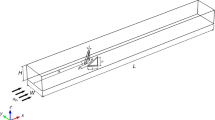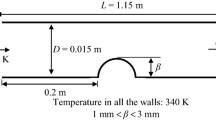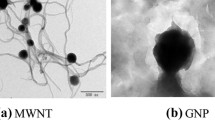Abstract
Thermal and flow characteristics of hybrid nanofluid inside a channel having vortex-generator with different wing shapes, is investigated numerically. Three different wing shapes, including rectangular, triangular, and trapezoidal, are considered. The geometrical configuration considered in this work is representative of a channel with three wings in each row; one mounted to the top plate and the other ones mounted to the bottom plate and this trend changes between the plates alternately. MgO-MWCNT (50:50) suspended in the ethylene glycol (EG) as base fluid with volume fractions of 0.1%, 0.2%, 0.4%, and 0.6% is considered as working fluid. The effects of volume fraction of the nanoparticles and type of wings in the Reynolds number range of 200–1600, are investigated. Heat transfer coefficient, pressure drop and performance evaluation criterion (PEC) are the most important parameters that investigated at different flow conditions. The results shown that rectangular wings leads to increase the heat transfer coefficient. In addition the channel with trapezoidal and triangular wings at the same volume fraction, have the higher values of PEC due to lower pressure drop. Also the result indicated that heat transfer coefficient are enhanced by increasing the nanoparticles volume fraction. According to obtained results, the trapezoidal wings with nanofluid volume of fraction of 0.6 and minimum Reynolds number leads to desirable performance from heat transfer and fluid flow viewpoint.











Similar content being viewed by others
Abbreviations
- Ac :
-
minimum free flow area (m2)
- At :
-
total surface area in contact with working fluid (m2)
- Cp :
-
specific heat (J kg-1 K-1)
- Dh :
-
hydraulic diameter (m)
- Fh :
-
fin height (m)
- FP :
-
fin pitch (m)
- h:
-
effective heat transfer coefficient (W m-2 K-1)
- k:
-
turbulent kinetic energy
- L:
-
channel length (m)
- \( \dot{m} \) :
-
mass flow rate (kg s-1)
- nt :
-
number of tabs
- \( \dot{Q} \) :
-
convective heat transfer rate (W)
- Rh :
-
rectangular wing height (m)
- Rw :
-
rectangular wing width (m)
- T:
-
temperature (K)
- Th :
-
triangular wing height (m)
- Tw :
-
triangular wing width (m)
- T:
-
fin thickness (m)
- U:
-
velocity (m s-1)
- Vl :
-
longitudinal vortex spacing (m)
- Vt :
-
transverse vortex spacing (m)
- wh :
-
trapezoidal wing height (m)
- ∆P:
-
pressure drop (Pa)
- ∆T:
-
temperature difference (K)
- x,y,z:
-
Cartesian coordinates
- ρ :
-
density (kg m-3)
- μ :
-
dynamic viscosity (kg m-1 s-1)
- λ :
-
thermal conductivity (W m-1 K-1)
- φ :
-
solid volume fraction
- δ :
-
Kronecker delta
- σ K :
-
effective Prandtl number
- σ ε :
-
Schmidt number
- ε :
-
rate of dissipation
- ave:
-
average
- b:
-
Bulk
- bf:
-
base fluid
- conv:
-
Convective
- f:
-
Fluid
- i,j:
-
x direction, y direction
- LMTD:
-
Logarithmic Mean Temperature Difference
- in:
-
inlet
- nf:
-
Nanofluid
- out:
-
outlet
- w:
-
Wall
- f :
-
friction factor
- Nu:
-
Nusselt number
- PEC:
-
performance evaluation criterion
- Re:
-
Reynolds number
References
Sheikhzadeh GA, Arefmanesh A, Kheirkhah MH, Abdollahi R (2011) Natural convection of cu–water nanofluid in a cavity with partially active side walls. Eur J Mech - B/Fluids 30:166–176
Abbasian Arani AA, Amani J, Hemmat Esfe M (2012) Numerical simulation of mixed convection flows in a square double lid-driven cavity partially heated using nanofluid. J Nanostruct 2(3):301–311
Sheikhzadeh GA, Hajilou M, Jafarian H (2014) Analysis of thermal performance of a Car radiator employing Nanofluid. Int J Mech Eng Appl 2(4):47–51
Dastmalchi M, Sheikhzadeh GA, Abbasian Arani AA (2015) Double-diffusive natural convective in a porous square enclosure filled with nanofluid. Int J Therm Sci 95:88–98
Abbasian Arani AA, Aberoumand H, Aberoumand S, Moghaddam AJ, Dastanian M (2016) An empirical investigation on thermal characteristics and pressure drop of ag-oil nanofluid in concentric annular tube. Heat Mass Transf 52(8):1693–1706
Abbasian Arani AA, Ababaei A, Sheikhzadeh GA, Aghaei A (2017) Numerical simulation of double-diffusive mixed convection in an enclosure filled with nanofluid using Bejan’s heatlines and masslines. Alex Eng J. https://doi.org/10.1016/j.aej.2017.03.034
Hemmat Esfe M, Karimpour R, Abbasian Arani AA, Shahram J (2017) Experimental investigation on non-Newtonian behavior of Al2O3-MWCNT/5W50 hybrid nano-lubricant affected by alterations of temperature, concentration and shear rate for engine applications. Int Commun Heat Mass Transf 82:97–102
Min CH, Qi CY, Kong XF, Dong JF (2010) Experimental study of rectangular channel with modified rectangular longitudinal vortex generators. Int J Heat Mass Transf 53:3023–3029
Zhou GB, Ye QL (2012) Experimental investigation of thermal and flow characteristics of curved trapezoidal-winglet type vortex generators. Appl Therm Eng 37:241–248
Colleoni A, Toutant A, Olalde G, Foucaunt JM (2013) Optimization of winglet vortex generators combined with riblets for wall/fluid heat exchanger enhancement. Appl Therm Eng 50:1092–1100
Al-khishali KJM, Ebaid MSY (2015) Numerical and experimental investigations of shape and location of vortex generators on fluid flow and heat transfer in a constant heat-fluxed rectangular duct. Adv Mech Eng 7:1–21
Kamboj R, Dhingra S, Singh G (2014) CFD simulation of heat transfer enhancement by plain and curved winglet type vertex generators with punched holes. In J Eng Res Gen Sci 2:648–659
Khoshvaght Aliabadi M, Zangouei S, Hormozi F (2015) Performance of a plate fin heat exchanger with vortex-generator channels: 3D-CFD simulation and experimental validation. Int J Therm Sci 88:180–192
Lu G, Zhou G (2016) Numerical simulation on performances of plane and curved winglet type vortex generator pairs with punched holes. Int J Heat Mass Transf 102:679–690
Khoshvaght Aliabadi M, Hormozi F, Zamzamian A (2014) Effects of geometrical parameters on performance of plate-fin heat exchanger: vortex-generator as core surface and nanofluid as working media. Appl Therm Eng 70:565–579
Ahmed HE, Ahmed MI, Yusoff MZ (2015) Heat transfer enhancement in a triangular duct using compound nanofluids and turbulators. Appl Therm Eng 91:191–201
Ahmed HE, Ahmed MI, Yusoff MZ, MNA H, Al-Ani H (2015) Experimental study of heat transfer augmentation in non-circular duct using combined nanofluids and vortex generator. Int J Heat Mass Transf 90:1197–1206
Ahmed HE, Yusoff MZ, Hawlader MNA, Ahmed MI, Salman BH, Kerbeet AS (2017) Turbulent heat transfer and nanofluid flow in a triangular duct with vortex generators. Int J Heat Mass Transf 105:495–504
Ahmed HE, Mohammed HA, Yusoff MZ (2012) An overview on heat transfer augmentation using vortex generators and nanofluids: approaches and applications. Renew Sust Energ Rev 16:5951–5993
Mamourian M, Milani-Shirvan K, Mirzakhanlari S, Rahimi AB (2016) Vortex generators position effect on heat transfer and nanofluid homogeneity: a numerical investigation and sensitivity analysis. Appl Therm Eng 107:1233–1247
Khoshvaght-Aliabadi M, Akbari M, Hormozi F (2016) An empirical study on vortex generator insert fitted in tubular heat exchangers with dilute cu-water nanofluid flow. Chin J Chem Eng 24:728–736
Ahmed HE, Mohammed HA, Yusoff MZ (2012) Heat transfer enhancement of laminar nanofluids flow in a triangular duct using vortex generator. Superlattice Microst 52:398–415
Sabaghan A, Edalatpour M, Charjouei-Moghadam M, Roohi E, Niazmand H (2016) Nanofluid flow and heat transfer in a microchannel with longitudinal vortex-generators: two-phase numerical simulation. Appl Therm Eng 100:179–189
Ebrahimi A, Rikhtegar F, Sabaghan A, Roohi E (2016) Heat transfer and entropy generation in a microchannel with longitudinal vortex generators using nanofluids. Energy 101:190–201
Syam Sundar L, Singh MK, Sousa ACM (2014) Enhanced heat transfer and friction factor of MWCNT–Fe3O4/water hybrid nanofluids. Int Commun Heat Mass Transf 52:73–83
Nuim Labib M, Nine MJ, Afrianto H, Chung H, Jeong H (2013) Numerical investigation on effect of base fluids and hybrid nanofluid in forced convective heat transfer. Int J Therm Sci 71:163–171
Huang D, Wu Z, Sunden B (2016) Effects of hybrid nanofluid mixture in plate heat exchangers. Exp Thermal Fluid Sci 72:190–196
Vafaei M, Afrand M, Sina N, Kalbasi R, Sourani F, Teimouri H (2017) Evaluation of thermal conductivity of MgO-MWCNTs/EG hybrid nanofluids based on experimental data by selecting optimal artificial neural networks. Phys E: Low-dimension Syst Nanostruct 85:90–96
Soltani O, Akbarin M (2016) Effects of temperature and particles concentration on the dynamic viscosity of MgO-MWCNT/ethylene glycol hybrid nanofluid: experimental study. Physica E84:564–570
Sarkarn J, Ghosh P, Adil A (2015) A review on hybrid nanofluids: recent research, development and applications. Renew Sust Energ Rev 43:164–177
Lu G, Zhou G (2016) Numerical simulation on performances of plane and curved winglet pair vortex generators in a rectangular channel and field synergy analysis. Int J Therm Sci 109:323–333
Pourfattah F, Motamedian M, Sheikhzadeh G, Toghraie D, Akbari OA (2017) The numerical investigation of angle of attack of inclined rectangular rib on the turbulent heat transfer of water-Al2O3 nanofluid in a tube. Int J Mech Sci:1106–1116
Khoshvaght Aliabadi M, Hormozi F, Zamzamian A (2014) Experimental analysis of thermal–hydraulic performance of copper–water nanofluid flow in different plate-fin channels. Exp Thermal Fluid Sci 52:248–258
Acknowledgements
The authors wish to thank the Energy Research Institute and the Research & Technology Administration of the University of Kashan for their support regarding this research (Grant No. 785398).
Author information
Authors and Affiliations
Corresponding author
Additional information
Publisher’s Note
Springer Nature remains neutral with regard to jurisdictional claims in published maps and institutional affiliations.
Rights and permissions
About this article
Cite this article
Sheikhzadeh, G.A., Barzoki, F.N., Arani, A.A.A. et al. Wings shape effect on behavior of hybrid nanofluid inside a channel having vortex generator. Heat Mass Transfer 55, 1969–1983 (2019). https://doi.org/10.1007/s00231-018-2489-x
Received:
Accepted:
Published:
Issue Date:
DOI: https://doi.org/10.1007/s00231-018-2489-x




